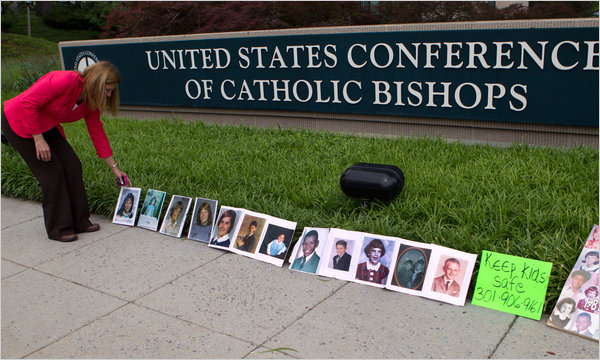By Laurie Goodstein
New York Times
May 18, 2011
http://www.nytimes.com/2011/05/19/us/19bishops.html?_r=1
 |
| Barbara Blaine of the Survivors Network of those Abused by Priests placed pictures of abuse victims outside the news conference in Washington on Wednesday. |
The criminologists hired by the nation’s Roman Catholic bishops to study the sexual abuse crisis in the church defended their findings on Wednesday at the bishops’ headquarters — in particular their thesis that the abuse peaked in the 1960s and 1970s and dropped off significantly by the mid-1980s.
Sexual abuse victims and experts in the field began to absorb and criticize what is thought to be the most extensive study ever conducted of child sexual abuse within an institution, produced after five years by researchers from the John Jay College of Criminal Justice at the City University of New York.
Karen Terry, the report’s principal investigator and the dean of research and strategic partnerships at John Jay, said Wednesday at a news conference: “The peak of this abuse crisis is historical. That peak is over.”
The report’s conclusion was counterintuitive to many Catholics and abuse victims, because the scandal itself did not peak until 2002 with the revelations that the archbishop of Boston had knowingly reassigned serial abusers to serve in ministries where they continued to have access to young people.
That practice appears still to have been at work until very recently, at least in Philadelphia, where a grand jury in February found that about three dozen priests accused of abuse and inappropriate behavior with minors were still in ministry.
Bishop Blase Cupich, chairman of the bishops’ committee on the protection of children and young people, said at the news conference that the Philadelphia situation was an “anomaly.”
Bishop Cupich said the bishops had made great strides in preventing abuse because of policies they adopted at their Dallas meeting in 2002, but he acknowledged: “If we want our people to trust us, we have to trust them. So we are doing our best to make sure that we are transparent with them.”
Victims groups accused the bishops of using the report and the researchers’ credibility to try to cap the 10-year scandal.
David Clohessy, national director of the Survivors Network of those Abused by Priests, said in an e-mail: “America’s bishops hope this will be their ‘Mission Accomplished’ moment, like George W. Bush on the aircraft carrier prematurely and conveniently declaring victory in Iraq. Their plan is to act as though the crisis has been clarified and is now past. It’s deceptive and disingenuous, but shrewd public relations.”
Among the most controversial findings in the report is the mountain-shaped graph that shows the number of abuse victims climbing through the 1960s, peaking in the 1970s and sharply declining from 1985 onward.
The report theorizes that priests coming of age in the 1940s and 1950s, growing up in families where sexuality was a taboo topic, and trained in seminaries that did not prepare them for lives of celibacy, went on to violate children during the social chaos of the sexual revolution.
Ms. Terry said in an interview that she could not say for sure that the abuse did not predate the 1960s. The researchers were contracted to study only the 1950s and onward.
“We did not investigate the ’20s, ’30s and ’40s,” Ms. Terry said, “so we don’t know what the level of abuse was at that time. Did it occur then? Of course. It occurred throughout society.
“Was there more abuse in the 1950s than was reported in our graph?” she continued. “No doubt. However, there is still an increase in the 1960s. That’s been shown each year the data has come in.”
David Finkelhor, director of the Crimes Against Children Research Center at the University of New Hampshire, said he found much of value in the report. Mr. Finkelhor said there was a parallel spike in society in general of sexual abuse of minors in the 1960s and ’70s. But he said it might simply be evidence that sexual abuse began to be more widely reported in those years.
“We did see that,” he said, “but we said these are cases that have always existed, and we are just hearing about them at the time.”
The report relies on data from the church, other researchers, treatment centers and interviews with abusers, victims and church officials.
Experts in sexual abuse agreed that the episodes of abuse by priests had indeed dropped in recent years, because of increased reporting, better screening and preparation of priests in seminaries and prevention programs for children.
The report found that in 1992, the bishops adopted five very sound principles to prevent abuse. But they were only guidelines, and while some bishops adopted them, others did not.
“What is clear to us was that in many cases the bishops did respond, but they were responding to their priests,” Ms. Terry said. “They were looking to help the priest, to treat the priest, to help him overcome his sickness. What they did not do was focus on the victims and the harm to the victims.”
Any original material on these pages is copyright © BishopAccountability.org 2004. Reproduce freely with attribution.